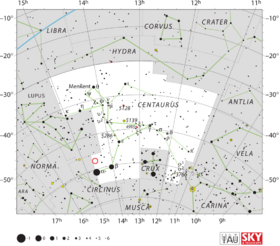Astronomy:V842 Centauri
| Observation data Equinox J2000.0]] (ICRS) | |
|---|---|
| Constellation | Centaurus |
| Right ascension | 14h 35m 52.568s[1] |
| Declination | −57° 37′ 35.39″[1] |
| Apparent magnitude (V) | 18.5 (pre-nova)[2] 4.6 (max during nova)[3] 16.5 (2010)[2] |
| Characteristics | |
| Variable type | nova[3] |
| Astrometry | |
| Distance | 4498+391 −254[4] ly (1379+120 −78[4] pc) |
| Absolute magnitude (MV) | −7.5 (max during nova)[3] |
| Details | |
| Mass | 0.88[5] M☉ |
| Other designations | |
Nova Centauri 1986, AAVSO 1428-57, Gaia DR2 5891405647833287296 | |
| Database references | |
| SIMBAD | data |

V842 Centauri, also known as Nova Centauri 1986, was a nova which occurred in 1986 in the constellation Centaurus. It was discovered by Robert H. McNaught of Siding Spring Observatory in Australia, on 22 November 1986. At the time of its discovery, it had an apparent magnitude of 5.6. It reached a peak magnitude of 4.6 one and a half days later, making it easily visible to the naked eye.[6]
V842 Centauri is considered a moderately fast nova, having faded by 3 magnitudes after 48 days.[3] Near the end of 1986, and early in 1987, its light curve showed a sharp drop in brightness, caused by the formation of dust. This dramatic fading lasted only about 50 days, before the nova brightened by about 2.5 magnitudes.[7] By 2010, it had faded to magnitude 16.5, but was still 2 magnitudes brighter than before the nova eruption.[2]
From its shell's expansion velocity, it is estimated to be at a distance of 1.5 kpc (4900 light-years) from Earth.[8] Another method, based on the system's extinction rate, gives a similar distance of 1.65 ± 0.54 kpc.[9] It was observed by the Gaia spacecraft, which measured a distance of 1.38 (+0.120, -0.078) kpc.[4]
The mass of the white dwarf in V842 Centauri is estimated at 0.88 solar masses. The system is likely seem from a low inclination.[5] An expanding nebula has been detected around V842 Centauri, formed by material ejected during the nova. It has two components, with diameters of 3.6" and 10.6", corresponding to material with different densities and expansion velocities.[8]
A 2009 photometric study of V842 Centauri found a possible 57 seconds period in the system's light curve, which was interpreted as the white dwarf's rotation period. An orbital period of 3.94 hours was calculated from variations of this period. V842 Centauri was then classified as an intermediate polar, with the third fastest rotation period for a cataclismic system.[10] However, two later studies revealed problems with this classification.[5][2]
In 1995, observations with the 3.9 meter Anglo-Australian Telescope detected a very small (~1.5 arc second diameter) nova remnant shell surrounding V842 Centauri.[11] By March 1998 the shell had expanded to 5.6 × 6.0 arc seconds.[12]
References
- ↑ 1.0 1.1 Brown, A. G. A. (August 2018). "Gaia Data Release 2: Summary of the contents and survey properties". Astronomy & Astrophysics 616: A1. doi:10.1051/0004-6361/201833051. Bibcode: 2018A&A...616A...1G. Gaia DR2 record for this source at VizieR.
- ↑ 2.0 2.1 2.2 2.3 Sion, Edward M.; Szkody, Paula; Mukadam, Anjum; Warner, Brian et al. (August 2013). "Multiwavelength Photometry and Hubble Space Telescope Spectroscopy of the Old Nova V842 Centaurus". The Astrophysical Journal 772 (2): 116. doi:10.1088/0004-637X/772/2/116. Article 116. Bibcode: 2013ApJ...772..116S.
- ↑ 3.0 3.1 3.2 3.3 Whitelock, P. A. (1987). "Nova Cen 1986". Monthly Notes of the Astron. Soc. Southern Africa 46: 72. Bibcode: 1987MNSSA..46...72W.
- ↑ 4.0 4.1 4.2 Schaefer, Bradley E. (2018). "The distances to Novae as seen by Gaia". Monthly Notices of the Royal Astronomical Society 481 (3): 3033–3051. doi:10.1093/mnras/sty2388. Bibcode: 2018MNRAS.481.3033S.
- ↑ 5.0 5.1 5.2 Luna, G. J. M.; Diaz, M. P.; Brickhouse, N. S.; Moraes, M. (June 2012). "XMM-Newton EPIC and OM observation of Nova Centauri 1986 (V842 Cen)". Monthly Notices of the Royal Astronomical Society: Letters 423 (1): L75–L78. doi:10.1111/j.1745-3933.2012.01260.x. Bibcode: 2012MNRAS.423L..75L.
- ↑ Whitelock, P.A. (January 1987). "Nova Cen 1986". Monthly Notes of the Astronomical Society of South Africa 46: 72. Bibcode: 1987MNSSA..46...72W. https://ui.adsabs.harvard.edu/abs/1987MNSSA..46...72W. Retrieved 1 January 2021.
- ↑ Smith, Craig H.; Aitken, David K.; Roche, Patrick F. (March 1994). "The mid-infrared spectral development of nova CEN 1986". Monthly Notices of the Royal Astronomical Society 267 (2): 225–230. doi:10.1093/mnras/267.2.225. Bibcode: 1994MNRAS.267..225S.
- ↑ 8.0 8.1 Tomov, T.; Swierczynski, E.; Mikolajewski, M.; Ilkiewicz, K. (April 2015). "SALT observations of southern post-novae". Astronomy & Astrophysics 576: A119. doi:10.1051/0004-6361/201424709. A119. Bibcode: 2015A&A...576A.119T.
- ↑ Özdönmez, Aykut; Güver, Tolga; Cabrera-Lavers, Antonio; Ak, Tansel (September 2016). "The distances of the Galactic novae". Monthly Notices of the Royal Astronomical Society 461 (2): 1177–1201. doi:10.1093/mnras/stw1362. Bibcode: 2016MNRAS.461.1177O.
- ↑ Woudt, Patrick A.; Warner, Brian; Osborne, Julian; Page, Kim (June 2009). "57-second oscillations in Nova Centauri 1986 (V842 Cen)". Monthly Notices of the Royal Astronomical Society 395 (4): 2177–2182. doi:10.1111/j.1365-2966.2009.14668.x. Bibcode: 2009MNRAS.395.2177W.
- ↑ Gill, C.D.; O'Brien, T.J. (October 1998). "Deep optical imaging of nova remnants: a southern sky sample". Monthly Notices of the Royal Astronomical Society 300 (1): 221–232. doi:10.1046/j.1365-8711.1998.01899.x. Bibcode: 1998MNRAS.300..221G.
- ↑ Downes, Ronald A.; Duerbeck, Hilmar W. (2000). "Optical Imaging of Nova Shells and the Maximum Magnitude-Rate of Decline Relationship". The Astronomical Journal 120 (4): 2007–2037. doi:10.1086/301551. Bibcode: 2000AJ....120.2007D. https://ui.adsabs.harvard.edu/abs/2000AJ....120.2007D. Retrieved 1 January 2021.
External links
- V842 Centauri
- V 842 Cen
- https://web.archive.org/web/20050907140444/http://www.tsm.toyama.toyama.jp/curators/aroom/var/nova/1980.htm
 |

